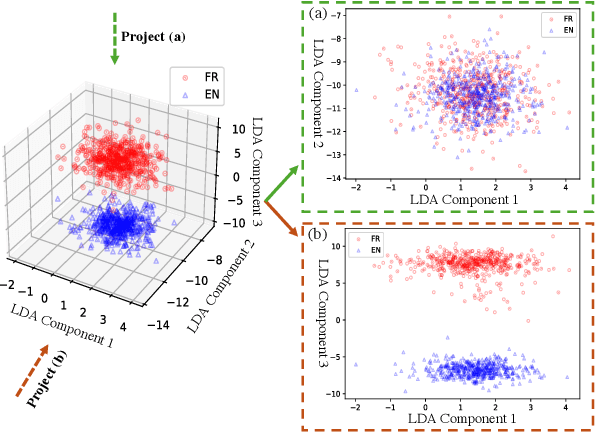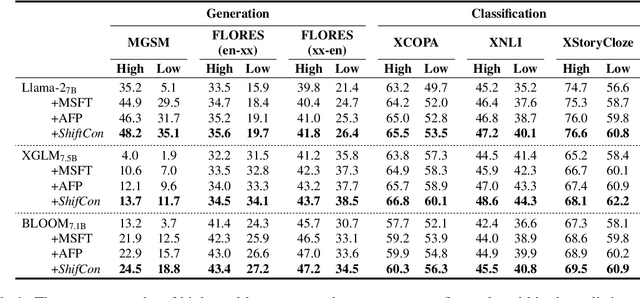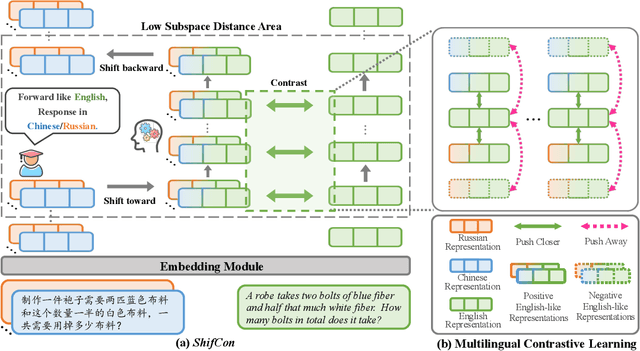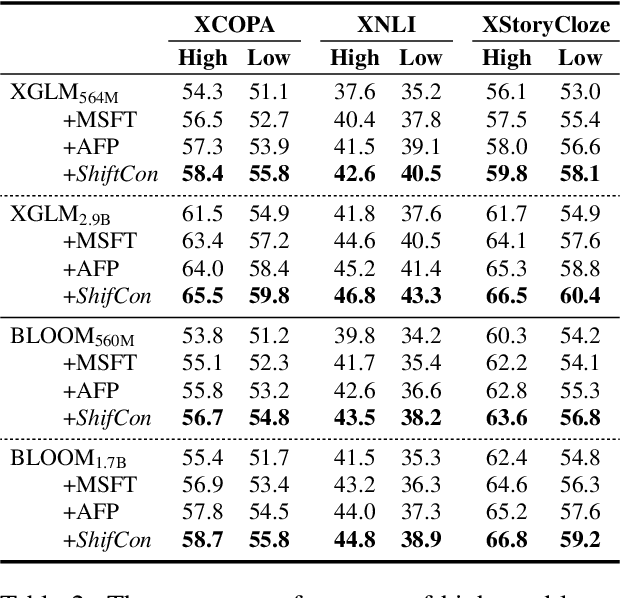Feng Yao
Finish First, Perfect Later: Test-Time Token-Level Cross-Validation for Diffusion Large Language Models
Oct 06, 2025Abstract:Diffusion large language models (dLLMs) have recently emerged as a promising alternative to autoregressive (AR) models, offering advantages such as accelerated parallel decoding and bidirectional context modeling. However, the vanilla decoding strategy in discrete dLLMs suffers from a critical limitation: once a token is accepted, it can no longer be revised in subsequent steps. As a result, early mistakes persist across iterations, harming both intermediate predictions and final output quality. To address this issue, we propose Tolerator (Token-Level Cross-Validation Refinement), a training-free decoding strategy that leverages cross-validation among predicted tokens. Unlike existing methods that follow a single progressive unmasking procedure, Tolerator introduces a two-stage process: (i) sequence fill-up and (ii) iterative refinement by remasking and decoding a subset of tokens while treating the remaining as context. This design enables previously accepted tokens to be reconsidered and corrected when necessary, leading to more reliable diffusion decoding outputs. We evaluate Tolerator on five standard benchmarks covering language understanding, code generation, and mathematics. Experiments show that our method achieves consistent improvements over the baselines under the same computational budget. These findings suggest that decoding algorithms are crucial to realizing the full potential of diffusion large language models. Code and data are publicly available.
Revisiting Reinforcement Learning for LLM Reasoning from A Cross-Domain Perspective
Jun 17, 2025Abstract:Reinforcement learning (RL) has emerged as a promising approach to improve large language model (LLM) reasoning, yet most open efforts focus narrowly on math and code, limiting our understanding of its broader applicability to general reasoning. A key challenge lies in the lack of reliable, scalable RL reward signals across diverse reasoning domains. We introduce Guru, a curated RL reasoning corpus of 92K verifiable examples spanning six reasoning domains--Math, Code, Science, Logic, Simulation, and Tabular--each built through domain-specific reward design, deduplication, and filtering to ensure reliability and effectiveness for RL training. Based on Guru, we systematically revisit established findings in RL for LLM reasoning and observe significant variation across domains. For example, while prior work suggests that RL primarily elicits existing knowledge from pretrained models, our results reveal a more nuanced pattern: domains frequently seen during pretraining (Math, Code, Science) easily benefit from cross-domain RL training, while domains with limited pretraining exposure (Logic, Simulation, and Tabular) require in-domain training to achieve meaningful performance gains, suggesting that RL is likely to facilitate genuine skill acquisition. Finally, we present Guru-7B and Guru-32B, two models that achieve state-of-the-art performance among open models RL-trained with publicly available data, outperforming best baselines by 7.9% and 6.7% on our 17-task evaluation suite across six reasoning domains. We also show that our models effectively improve the Pass@k performance of their base models, particularly on complex tasks less likely to appear in pretraining data. We release data, models, training and evaluation code to facilitate general-purpose reasoning at: https://github.com/LLM360/Reasoning360
ProDiff: Prototype-Guided Diffusion for Minimal Information Trajectory Imputation
May 29, 2025Abstract:Trajectory data is crucial for various applications but often suffers from incompleteness due to device limitations and diverse collection scenarios. Existing imputation methods rely on sparse trajectory or travel information, such as velocity, to infer missing points. However, these approaches assume that sparse trajectories retain essential behavioral patterns, which place significant demands on data acquisition and overlook the potential of large-scale human trajectory embeddings. To address this, we propose ProDiff, a trajectory imputation framework that uses only two endpoints as minimal information. It integrates prototype learning to embed human movement patterns and a denoising diffusion probabilistic model for robust spatiotemporal reconstruction. Joint training with a tailored loss function ensures effective imputation. ProDiff outperforms state-of-the-art methods, improving accuracy by 6.28\% on FourSquare and 2.52\% on WuXi. Further analysis shows a 0.927 correlation between generated and real trajectories, demonstrating the effectiveness of our approach.
Training Language Models to Generate Quality Code with Program Analysis Feedback
May 28, 2025Abstract:Code generation with large language models (LLMs), often termed vibe coding, is increasingly adopted in production but fails to ensure code quality, particularly in security (e.g., SQL injection vulnerabilities) and maintainability (e.g., missing type annotations). Existing methods, such as supervised fine-tuning and rule-based post-processing, rely on labor-intensive annotations or brittle heuristics, limiting their scalability and effectiveness. We propose REAL, a reinforcement learning framework that incentivizes LLMs to generate production-quality code using program analysis-guided feedback. Specifically, REAL integrates two automated signals: (1) program analysis detecting security or maintainability defects and (2) unit tests ensuring functional correctness. Unlike prior work, our framework is prompt-agnostic and reference-free, enabling scalable supervision without manual intervention. Experiments across multiple datasets and model scales demonstrate that REAL outperforms state-of-the-art methods in simultaneous assessments of functionality and code quality. Our work bridges the gap between rapid prototyping and production-ready code, enabling LLMs to deliver both speed and quality.
Next-Token Prediction Task Assumes Optimal Data Ordering for LLM Training in Proof Generation
Oct 30, 2024



Abstract:In the field of large language model (LLM)-based proof generation, despite being trained on extensive corpora such as OpenWebMath and Arxiv, these models still exhibit only modest performance on proving tasks of moderate difficulty. We believe that this is partly due to the suboptimal order of each proof data used in training. Published proofs often follow a purely logical order, where each step logically proceeds from the previous steps based on the deductive rules. However, this order aims to facilitate the verification of the proof's soundness, rather than to help people and models learn the discovery process of the proof. In proof generation, we argue that the optimal order for one training data sample occurs when the relevant intermediate supervision for a particular proof step in the proof is always positioned to the left of that proof step. We call such order the intuitively sequential order. We validate our claims using two tasks: intuitionistic propositional logic theorem-proving and digit multiplication. Our experiments verify the order effect and provide support for our explanations. We demonstrate that training is most effective when the proof is in the intuitively sequential order. Moreover, the order effect and the performance gap between models trained on different data orders are substantial -- with an 11 percent improvement in proof success rate observed in the propositional logic theorem-proving task, between models trained on the optimal order compared to the worst order.
ShifCon: Enhancing Non-Dominant Language Capabilities with a Shift-based Contrastive Framework
Oct 25, 2024



Abstract:Although fine-tuning Large Language Models (LLMs) with multilingual data can rapidly enhance the multilingual capabilities of LLMs, they still exhibit a performance gap between the dominant language (e.g., English) and non-dominant ones due to the imbalance of training data across languages. To further enhance the performance of non-dominant languages, we propose ShifCon, a Shift-based Contrastive framework that aligns the internal forward process of other languages toward that of the dominant one. Specifically, it shifts the representations of non-dominant languages into the dominant language subspace, allowing them to access relatively rich information encoded in the model parameters. The enriched representations are then shifted back into their original language subspace before generation. Moreover, we introduce a subspace distance metric to pinpoint the optimal layer area for shifting representations and employ multilingual contrastive learning to further enhance the alignment of representations within this area. Experiments demonstrate that our ShifCon framework significantly enhances the performance of non-dominant languages, particularly for low-resource ones. Further analysis offers extra insights to verify the effectiveness of ShifCon and propel future research
TemporalBench: Benchmarking Fine-grained Temporal Understanding for Multimodal Video Models
Oct 15, 2024



Abstract:Understanding fine-grained temporal dynamics is crucial for multimodal video comprehension and generation. Due to the lack of fine-grained temporal annotations, existing video benchmarks mostly resemble static image benchmarks and are incompetent at evaluating models for temporal understanding. In this paper, we introduce TemporalBench, a new benchmark dedicated to evaluating fine-grained temporal understanding in videos. TemporalBench consists of ~10K video question-answer pairs, derived from ~2K high-quality human annotations detailing the temporal dynamics in video clips. As a result, our benchmark provides a unique testbed for evaluating various temporal understanding and reasoning abilities such as action frequency, motion magnitude, event order, etc. Moreover, it enables evaluations on various tasks like both video question answering and captioning, both short and long video understanding, as well as different models such as multimodal video embedding models and text generation models. Results show that state-of-the-art models like GPT-4o achieve only 38.5% question answering accuracy on TemporalBench, demonstrating a significant gap (~30%) between humans and AI in temporal understanding. Furthermore, we notice a critical pitfall for multi-choice QA where LLMs can detect the subtle changes in negative captions and find a centralized description as a cue for its prediction, where we propose Multiple Binary Accuracy (MBA) to correct such bias. We hope that TemporalBench can foster research on improving models' temporal reasoning capabilities. Both dataset and evaluation code will be made available.
Configurable Foundation Models: Building LLMs from a Modular Perspective
Sep 04, 2024



Abstract:Advancements in LLMs have recently unveiled challenges tied to computational efficiency and continual scalability due to their requirements of huge parameters, making the applications and evolution of these models on devices with limited computation resources and scenarios requiring various abilities increasingly cumbersome. Inspired by modularity within the human brain, there is a growing tendency to decompose LLMs into numerous functional modules, allowing for inference with part of modules and dynamic assembly of modules to tackle complex tasks, such as mixture-of-experts. To highlight the inherent efficiency and composability of the modular approach, we coin the term brick to represent each functional module, designating the modularized structure as configurable foundation models. In this paper, we offer a comprehensive overview and investigation of the construction, utilization, and limitation of configurable foundation models. We first formalize modules into emergent bricks - functional neuron partitions that emerge during the pre-training phase, and customized bricks - bricks constructed via additional post-training to improve the capabilities and knowledge of LLMs. Based on diverse functional bricks, we further present four brick-oriented operations: retrieval and routing, merging, updating, and growing. These operations allow for dynamic configuration of LLMs based on instructions to handle complex tasks. To verify our perspective, we conduct an empirical analysis on widely-used LLMs. We find that the FFN layers follow modular patterns with functional specialization of neurons and functional neuron partitions. Finally, we highlight several open issues and directions for future research. Overall, this paper aims to offer a fresh modular perspective on existing LLM research and inspire the future creation of more efficient and scalable foundational models.
Data Contamination Can Cross Language Barriers
Jun 19, 2024Abstract:The opacity in developing large language models (LLMs) is raising growing concerns about the potential contamination of public benchmarks in the pre-training data. Existing contamination detection methods are typically based on the text overlap between training and evaluation data, which can be too superficial to reflect deeper forms of contamination. In this paper, we first present a cross-lingual form of contamination that inflates LLMs' performance while evading current detection methods, deliberately injected by overfitting LLMs on the translated versions of benchmark test sets. Then, we propose generalization-based approaches to unmask such deeply concealed contamination. Specifically, we examine the LLM's performance change after modifying the original benchmark by replacing the false answer choices with correct ones from other questions. Contaminated models can hardly generalize to such easier situations, where the false choices can be \emph{not even wrong}, as all choices are correct in their memorization. Experimental results demonstrate that cross-lingual contamination can easily fool existing detection methods, but not ours. In addition, we discuss the potential utilization of cross-lingual contamination in interpreting LLMs' working mechanisms and in post-training LLMs for enhanced multilingual capabilities. The code and dataset we use can be obtained from \url{https://github.com/ShangDataLab/Deep-Contam}.
Evaluating the Smooth Control of Attribute Intensity in Text Generation with LLMs
Jun 06, 2024Abstract:Controlling the attribute intensity of text generation is crucial across scenarios (e.g., writing conciseness, chatting emotion, and explanation clarity). The remarkable capabilities of large language models (LLMs) have revolutionized text generation, prompting us to explore such \emph{smooth control} of LLM generation. Specifically, we propose metrics to assess the range, calibration, and consistency of the generated text's attribute intensity in response to varying control values, as well as its relevance to the intended context. To quantify the attribute intensity and context relevance, we propose an effective evaluation framework leveraging the Elo rating system and GPT4, both renowned for their robust alignment with human judgment. We look into two viable training-free methods for achieving smooth control of LLMs: (1) Prompting with semantic shifters, and (2) Modifying internal model representations. The evaluations of these two methods are conducted on $5$ different attributes with various models. Our code and dataset can be obtained from \url{https://github.com/ShangDataLab/Smooth-Control}.
 Add to Chrome
Add to Chrome Add to Firefox
Add to Firefox Add to Edge
Add to Edge